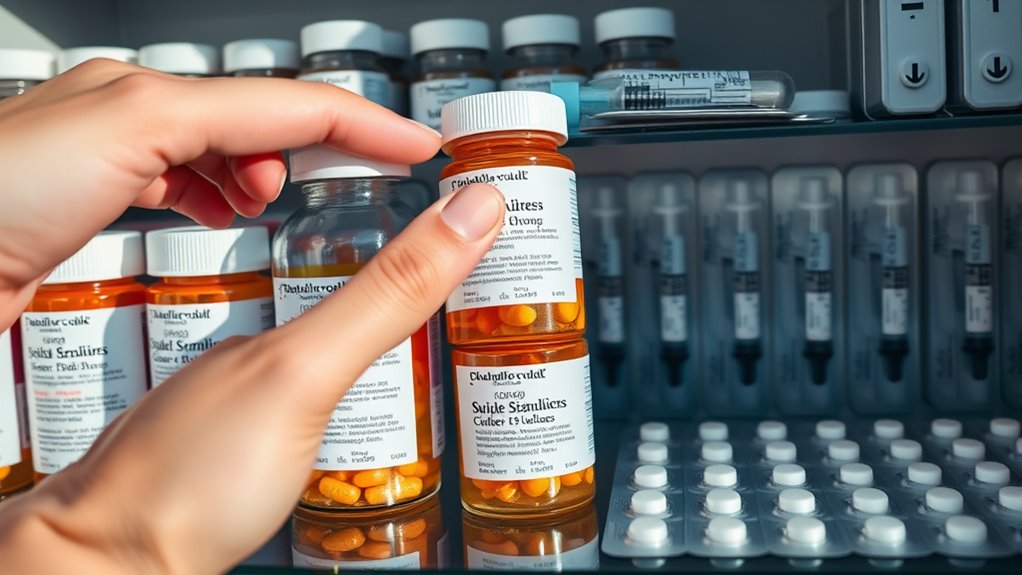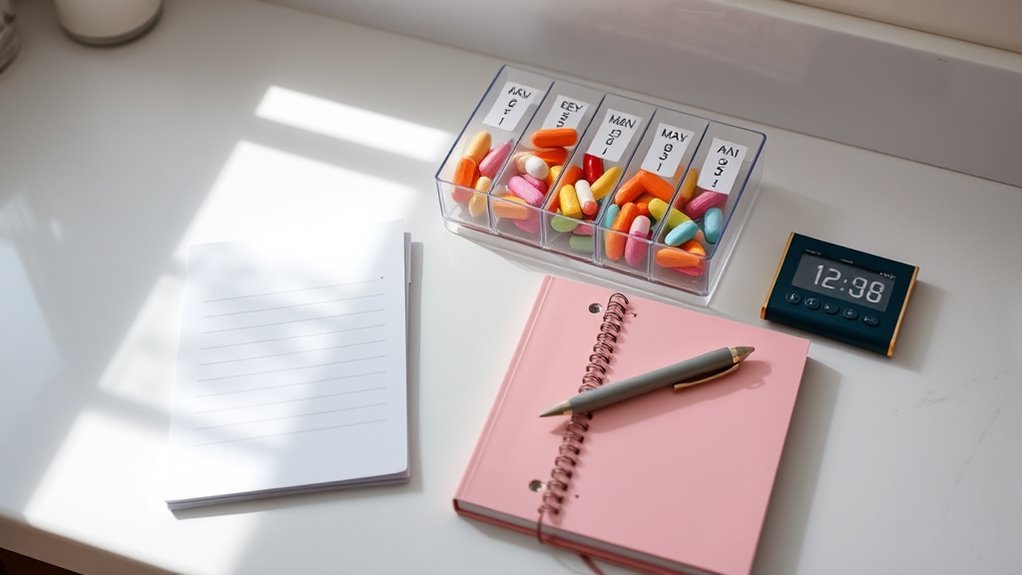To manage medications safely, work closely with your healthcare team and pharmacist to stay updated on your regimen. Follow all dosage instructions, use reminders, and keep medications organized in easy-to-access containers. Store medicines properly out of children’s reach, check expiration dates regularly, and dispose of expired drugs properly. Use technology like alarms or apps for refills and safety alerts. Combining these practices helps protect your health—learn more ways to keep your medication routines secure.
Key Takeaways
- Collaborate with healthcare providers and pharmacists, sharing complete medication lists for safe management and review.
- Use reminders, routines, and organized systems like pill organizers to promote medication adherence.
- Store medications properly in original containers, away from children and pets, and check expiration dates regularly.
- Utilize technology such as alarms, digital tracking, and barcode scanning to enhance safety and accuracy.
- Regularly review and update medication plans, and dispose of expired medicines responsibly to maintain safety.
Collaborate With Your Healthcare Team and Pharmacist

To manage your medications safely, it’s vital to work closely with your healthcare team and pharmacist. Effective communication ensures everyone stays informed about your medication review, so they can identify potential drug interactions and side effects. Sharing your complete medication list, including OTC drugs and supplements, helps prevent adverse interactions. Regular consultations allow your healthcare team to adjust your medications as needed and update you on new treatment options. Your pharmacist can guide you on medication safety, proper storage, and help address any concerns about side effects or drug interactions. Additionally, understanding the role of medication review is crucial for maintaining your safety and optimizing your treatment plan. This process often incorporates knowledge of medication safety to help you stay aligned with your health goals and receive guidance on your personal well-being. Proper documentation and communication also support compliance with medication regimens, ensuring you follow your prescribed plan accurately. Staying informed about patient education can empower you to make better decisions about your health. By maintaining clear, ongoing communication, you stay proactive about your health, guaranteeing your medication plan aligns with your goals and minimizes risks.
Follow Prescribed Dosage and Usage Instructions

Following your healthcare provider’s instructions precisely is essential for medication safety and effectiveness. Always take your medication exactly as prescribed, including the correct dosage, timing, and frequency. Proper medication management helps prevent errors and ensures optimal treatment outcomes. Changing the amount or schedule without consulting your doctor or pharmacist can be dangerous. Skipping doses or taking more than prescribed may reduce the medication’s effectiveness or cause harmful side effects. To ensure adherence, use a medication schedule or reminder system that helps you follow the prescribed instructions closely. Carefully read all label instructions, especially regarding food, liquids, or other substances that may affect your medication. Being aware of retail store hours and other service times can influence when you pick up your prescriptions or seek assistance. Establishing a consistent routine can also support medication adherence and make it easier to remember your doses. Staying consistent with your prescribed dosage and usage instructions is key to achieving the best health outcomes and avoiding potential complications. Additionally, understanding how infant sleep and family routines can impact medication schedules may help you plan more effectively.
Stay Organized and Establish a Routine

Staying organized helps you take your medications reliably and safely. Using pill organizers, setting daily reminders, and keeping your medications visible make it easier to stick to your routine. A community engagement approach can also provide additional support and accountability for managing your medications effectively. Incorporating these habits into your day guarantees you won’t forget or double up on doses. Being aware of medication safety guidelines ensures proper handling and storage of your prescriptions. Developing a consistent routine can further reinforce your medication management habits and reduce the risk of errors. Additionally, understanding medication process strategies can help you cope with any feelings of stress or frustration related to medication management.
Use Pill Organizers
Have you considered using pill organizers to keep your medications on track? They’re a simple way to boost medication safety and improve medication management.
With compartments labeled for morning, afternoon, evening, and bedtime, you’ll find it easier to take medication consistently. Using weekly or monthly pill containers helps prevent missed doses, especially after hospital stays or surgeries. Understanding medication adherence is key to managing health effectively, and pill organizers support this goal. Proper organization can also help you monitor your medication routine more effectively.
Color-coded or size-specific pill organizers can also help you distinguish between different medications and doses, reducing errors. Incorporating organized storage solutions can further streamline your medication management process and reduce clutter around your medication area. Additionally, considering electric bikes with high power output can make errands easier, especially if mobility is a concern.
Incorporating pill organizers into your daily routine—pairing them with meals or daily activities—promotes adherence.
Remember to review and refill your pill organizer regularly so all medications are accounted for and taken as scheduled.
Staying organized with pill organizers makes taking medication safer and more manageable. Utilize vertical storage solutions to maximize space and keep your medication area tidy.
Set Daily Reminders
Ever wonder how to guarantee you never miss a medication dose? Setting daily reminders on your phone or digital device helps keep your medication schedule on track. Alarms or alerts can be programmed to go off at specific times, offering visual or auditory cues. Using pill organizers with labeled compartments makes adherence easier and reduces missed or double doses. Incorporate medication times into daily routines—like with meals or bedtime—to build habits. Keeping a written checklist visible in your living space also reinforces your routine. Being aware of divorce guidance and related support resources can help in managing overall wellness. Additionally, understanding cultural celebrations related to health can motivate consistency and positive reinforcement. Establishing a routine can also help integrate medication times seamlessly into daily life. Here’s a quick comparison:
| Reminder Type | Benefits | Best Use Case |
|---|---|---|
| Phone alerts | Customizable, easy to set up | Busy schedules |
| Pill organizers | Simplifies adherence, reduces errors | Daily medication management |
| Written checklists | Visual prompt, reinforces routine | Quiet environments |
| Routine cues | Establishes consistent habits | Integrating into daily life |
Keep Medications Visible
Keeping your medications visible is a simple yet effective way to stay organized and stick to your routine. When your medication is in a dedicated, visible spot, you’re less likely to miss doses. Using pill organizers or labeled containers keeps your storage systematic and easy to access. Establishing consistent timing, like after meals or before bed, creates a dependable routine that becomes second nature. Placing reminders such as notes or alarms near your medication area supports timely dosing and reinforces organization. Regularly review your medication list and update your storage setup to avoid confusion. Incorporating data-driven strategies can help monitor adherence and improve overall medication management. Utilizing automation tools can further streamline your medication schedule and ensure consistency. Additionally, organizing your medications within a medication management system can help you keep track of refills and expiration dates to prevent running out or using expired medicines. Maintaining a medication adherence habit enhances safety and supports your health goals.
Be Aware of Interactions and Side Effects

Understanding how medications interact with each other and with foods is crucial for your safety. Drug interactions can reduce the effectiveness of your medications or trigger side effects like drowsiness, dry mouth, or upset stomach.
Over-the-counter drugs and supplements can also interfere with prescribed medications, so always check with your healthcare provider before adding anything new.
Some medications, like blood thinners or insulin, pose higher risks and require careful monitoring to prevent serious complications.
Regularly reviewing all your medications with your healthcare provider helps identify potential interactions and minimize side effects.
Staying informed and communicating openly with your healthcare team ensures you manage your medications safely and avoid harmful reactions. Your awareness can make a significant difference in your health outcomes.
Maintain Proper Storage and Refill Medications Timely

Proper storage of your medications is essential to maintain their effectiveness and safety. Keep them in their original containers, in a cool, dry place away from direct sunlight and humidity.
Store medications in original containers, cool, dry places away from sunlight to ensure safety and effectiveness.
Store medications out of reach of children and pets, ideally in a secure, childproof location. Regularly check expiration dates and dispose of expired or unused medications properly through pharmacy take-back programs.
Refill prescriptions before they run out to avoid gaps in treatment and ensure continuous management. Use reminder systems like alarms, pill organizers, or apps to track when to refill medications and prevent missed doses.
Proper storage and timely refills help preserve medication potency, minimize risks, and guarantee you get the full benefit of your treatment.
Implement Safety Protocols and Utilize Technology

Implementing safety protocols and leveraging technology are key steps in reducing medication errors and enhancing patient safety. By following strict protocols for high-alert medications, like requiring double-checks, you greatly decrease errors and patient harm.
Using electronic prescribing and barcode scanning systems guarantees accurate medication administration, eliminating risks from illegible handwriting or manual mistakes. Digital tools, including electronic health records and apps, enable real-time tracking, reminders, and detailed documentation of doses and patient info.
Technology-driven alerts for drug interactions and allergies help prevent adverse reactions and promote safe prescribing. Regular staff training on these protocols and new technology guarantees proper implementation and sustains high standards of medication safety.
Combining protocols and technology creates a safer environment and minimizes errors in medication management.
Frequently Asked Questions
What Are the 5 Steps of Medication Safety?
You want to know the five steps of medication safety. First, you prescribe correctly by verifying patient info and providing clear instructions.
Then, you dispense accurately, double-checking labels and storage.
Next, you administer properly, following doses and timing.
You also monitor for side effects and effectiveness, watching for adverse reactions.
Finally, you review the medication’s impact and adjust treatment as needed, ensuring safe, effective care throughout.
What Are the 7 Steps of Medication Safety?
Think of medication safety as a carefully choreographed dance. You start by prescribing accurately, ensuring the right steps. Next, you label correctly, guiding the patient clearly. Proper dispensing follows, making sure they receive the right move.
Educating the patient is like teaching the routine, while verifying medication confirms the steps. Monitoring for side effects and proper storage keep the dance safe and smooth, completing the seven essential steps.
What Are Strategies for Using Medications Safely?
You should create a consistent medication routine using alarms, pill organizers, or digital reminders to prevent missed doses.
Always follow your healthcare provider’s instructions precisely, and consult them before making any changes.
Keep an updated medication list, store medications properly, and stay informed about potential side effects.
Refill prescriptions on time, and safely dispose of expired or unused meds to ensure your safety and effectiveness.
What Are the 5 R’s of Medication Management?
Think of the 5 R’s as your trusty compass guiding medication safety. You guarantee the right patient receives the correct medication, dose, route, and time, like a skilled navigator avoiding hazards.
Conclusion
By working closely with your healthcare team, staying organized, and following instructions, you can prevent medication errors. When you keep your medications stored properly and refill them on time, it’s like catching a lucky break in your daily routine. Embracing safety protocols and tech tools makes managing meds feel effortless—like a small coincidence that keeps you healthy and safe every day. Remember, careful management isn’t just routine; it’s your best safeguard.









